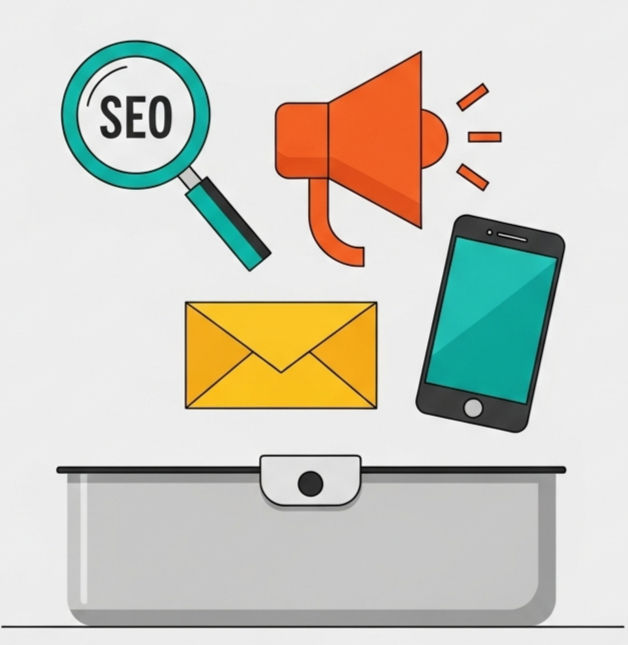Clicks, Conversions & Code: Everyone’s Playbook to Digital Marketing
- Mansee Mohta
- Sep 3
- 7 min read
Digital marketing is “the use of websites, apps, mobile devices, social media, search engines, and other digital means to promote and sell products and services”. In today’s world, consumers spend hours each day online, so having a strong digital marketing strategy is no longer optional, nearly your entire audience is just a click away.

Digital marketing’s power lies in its reach and measurability. Unlike traditional ads, a targeted digital campaign lets you choose exactly who sees your message, and everything is trackable. Even with a tiny budget, digital marketing can deliver big results. For example, businesses typically earn about ₹5 for every ₹1 spent on digital marketing (that’s a 500% ROI!), and email marketing alone can yield a whopping ₹500 for every ₹1. When marketing geeks see figures like that, they know it’s time to rally.
The Digital Marketing Toolkit
Successful campaigns use a mix of channels and tactics. Think of digital marketing as a toolbox: each tool has its purpose. Here are the core pieces in most strategies:
Image: The four pillars of digital marketing – SEO, Social Media, Mobile (SMS), and Email – highlight the main channels in a strong online strategyslicktext.comslicktext.com.
Search Engine Optimization (SEO): SEO means optimizing your website and content so it ranks highly on search engines. Why is this vital? Because 75% of users never click past the first page. If someone Googles “best pizza [YourCity]” or “how to knit a scarf,” good SEO makes your site appear at the top. More visibility means more traffic and potential customers every day.
Content Marketing: Great content builds trust. This includes blog posts, videos, infographics, e-books anything that provides value or entertainment. The goal is to attract your audience with helpful information, not just hard-sell. Investopedia explains that content marketing “reaches potential customers through the use of written, visual, or video content that interests them,” which is then promoted via social, email, or SEO. For example, a gardening store might publish a video on how to plant spring flowers, attracting hobbyist gardeners and establishing the shop as an expert. Over time, this builds trust and keeps your brand top-of-mind.
Social Media Marketing: Platforms like Facebook, Instagram, Twitter, LinkedIn, TikTok, etc. are essential for connecting with customers. In fact, over 2.3 billion people use social media. Use these channels to build community: share photos, stories, and updates. It’s a place to showcase your brand’s personality. Organic posts build goodwill, and you can also run paid ads to target specific audiences (demographics, interests, etc.). Bonus: about 70% of users expect customer support via social, so it’s a direct line to your audience.
Email Marketing: Don’t underestimate email it’s still a superstar. An email list gives you direct access to interested readers. You can send newsletters, promotions, or tips right into their inbox. As noted above, email often yields ₹500 for every ₹1. Even a simple monthly newsletter with a special offer can drive repeat business. (Tip: personalize your emails and include a clear call-to-action.)
Paid Advertising (PPC): Pay-per-click ads put your message in front of searchers or social-media users. Google Ads and Facebook/Instagram Ads let you target keywords, demographics, interests, and more. You only pay when someone clicks. According to Investopedia, PPC campaigns can segment audiences very precisely. It’s like renting prime billboard space on the internet, immediate visibility to people actively searching or scrolling.
Affiliate & Influencer Marketing: These tap into others’ audiences. In affiliate marketing, bloggers or affiliates promote your products and earn a commission on each sale. Influencers (YouTubers, Instagram stars, etc.) work similarly by reviewing or featuring your product to their followers. Big companies (like Amazon) pay out millions to affiliates each year, showing how powerful this can be. Essentially, it’s trusted word-of-mouth on a large scale.
SMS/Mobile Marketing: Text messages get opened, nearly 98% of the time. If customers opt in, you can send short updates or flash deals straight to their phones. A timely “Sale starts tomorrow!” text can trigger an instant response. (Just be sure not to spam!)
Analytics & Optimization: Finally, track everything and improve continually. Use tools like Google Analytics, social-platform insights, and email dashboards to monitor performance. Key metrics include website traffic, engagement (likes, shares, comments), conversion rate, and ROI. By measuring these, you see what’s working. If an ad or post underperforms, tweak it. Data-driven adjustments (A/B tests, etc.) keep your strategy sharp and growing.
Building Your Digital Strategy
Even a “dummy’s guide” needs a plan. Here’s a step-by-step approach:
Know Your Audience: Who are you trying to reach? Define your ideal customer (age, interests, pain points). For example, if you sell eco-friendly sneakers, your audience might be environmentally conscious young adults. Tailor your message to what they care about.
Set Clear Goals: What do you want to achieve? More website traffic? Leads? Sales? Make goals specific and measurable (e.g. “increase online sales by 20% in 6 months”). This will guide which tactics you choose.
Choose the Right Channels: Use the channels your audience uses. If you target professionals, LinkedIn and industry blogs might be best. If you target teens, consider TikTok or Instagram. It’s better to excel on a couple of platforms than to spread yourself thin.
Plan Your Content: Decide what content or ads you’ll create. This might be blog articles, videos, social posts, or email sequences. Create a content calendar of topics and deadlines. Ensure each piece aligns with your brand voice and goals.
Allocate Budget & Resources: Determine your budget and tools. Will you spend on ads, design, or video production? Even a small budget can be powerful. Allocate funds for advertising and any platforms or freelancers you need.
Implement & Test: Launch campaigns on a small scale first. Use A/B testing (compare two versions of an email subject line, ad image, etc.) to learn what works best. Digital marketing allows quick experiments, so keep testing new ideas.
Measure KPIs: Track performance using analytics. Monitor website traffic, social engagement, lead signups, and sales. For example, SlickText recommends key metrics like traffic, engagement, conversion rate, and ROI. If something isn’t working (e.g. a low click-through rate), adjust it or try a new approach.
Iterate: Data is your friend. Successful marketers make decisions based on analytics, not guesswork. Keep refining your strategy: tweak content, pause what’s underperforming, and test new ideas. Over time, your campaigns will become more effective.
Here’s a simple checklist to summarize:
Identify your target audience and their needs.
Pick the best channels for that audience (social, email, search, etc.).
Create high-quality, relevant content for each channel.
Allocate your budget wisely (ads vs. content vs. tools).
Track performance and adjust on the fly.
A Digital Marketing Scenario
Let’s make this concrete. Meet Lila’s Cupcake Shop, a small bakery hoping to sweeten its sales. Lila uses a blend of digital tactics:

SEO & Local Search: Lila optimizes her website for searches like “cupcakes [HerCity]” and “best cupcakes nearby,” and she claims her Google Business listing. Now when locals Google “best cupcakes,” Lila’s shop appears near the top (remember, 75% of searchers never leave page 1).
Social Media: She posts mouth-watering photos of her cupcakes on Instagram and Facebook. With billions on social media, her photos reach more eyes. Lila engages by replying to comments and using popular hashtags (like #CupcakeLove).
Email Newsletter: At checkout, customers give their email. Each week, Lila sends a newsletter with a new flavor and a coupon. Because email ROI is huge, even one well-written email (like a monthly special offer) can boost sales. It keeps her shop on everyone’s mind.
Facebook Ads: Lila runs a small Facebook ad targeting people in her city who love baked goods. This brings new followers to her page and foot traffic to the store.
SMS Alerts: For holidays (Valentine’s, Halloween), Lila sends a quick text blast (“Valentine’s Cupcake Sale starts tomorrow!”). Texts get seen right away (~98% open rate), so even a brief message drives instant action.
Measure & Adapt: Lila monitors Google Analytics and Facebook Insights. She sees which posts and ads bring visitors to her website. If an Instagram post is popular on weekends, she posts more then. If an ad flops, she stops it. This data-driven approach keeps improving her strategy.
Result: Over a few months, more locals know about Lila’s Cupcakes. Her weekly sales steadily increase. All because Lila mixed smart planning (target audience + content) with ongoing optimization.
This scenario shows the playbook in action. Define goals, choose channels, create engaging content, measure results, and iterate. Every business will have its own flavor of digital marketing, but the recipe is similar.
Key Takeaways and Best Practices
Be Audience-Centric: Always start with your customer. What problems or interests do they have? What entertains them? Tailor your content and ads to those needs.
Quality Over Quantity: You don’t have to be on every platform. It’s better to do a few things exceptionally well than to spread yourself thin.
Consistent Branding: Use a consistent voice and visuals across channels. Every tweet, blog, or email should “sound” like you. Even using the same colors or fonts helps people recognize your brand.
Storytelling Wins: Humans love stories. Weave narratives into your marketing (company history, customer success stories, behind-the-scenes). A compelling story makes your brand memorable.
Test and Learn: Run A/B tests on subject lines, images, and calls-to-action. Small experiments teach you what your audience responds to. Data-driven tweaks make a big difference.
Stay Curious: Digital marketing evolves fast. Follow industry blogs, try new formats (like short-form video or live streams), or experiment with trending tools (even AI-powered ad creators!). Staying informed keeps your strategy fresh.
Remember, digital marketing is not a one-time trick but an ongoing journey. As long as you keep measuring, learning, and adapting, your online presence will only get stronger.
Now go forth, launch that campaign, and let the data (and your inner marketing geek) guide you to online success—dummy-proof style!
Stay tuned for the next blog which delves deeper into how to track performance on digital marketing!






Comments